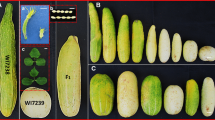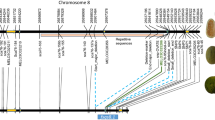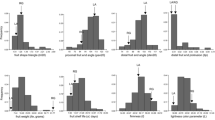Abstract
In two previous quantitative trait locus (QTL) mapping studies conducted inLycopersicon esculentum x L. pimpinellifolium BC1 and BC2 populations we had localized a major QTL for fruit shape,fs8.1, to a ca. 20 cM interval on the short arm of chromosome 8, flanked by markers TG176 and CT92. At this QTL the allele from the wild species reduces the length of fruit, giving round-shaped fruit. In order to define more precisely the location offs8.1, near-isogenic lines (NILs) segregating for the region of interest were developed. The results from substitution mapping show that no recombination occurred betweenfs8.1 and the marker CD40 in 322 meioses. The gene action forfs8.1 was determined in a BC4F3 population to be partial dominance. The main effect offs8.1 is exerted on fruit length while fruit diameter is not significantly affected. A highly significant correlation (r=0.89;P<0.01) was found between fruit shape and ovary shape indicating that thefs8.1 gene product acts early in ovary development (preanthesis). Implications for the evolution of fruit shape and the feasibility of map-based cloning of this QTL are discussed.
Similar content being viewed by others
References
Alpert KB, Tanksley SD: High-resolution mapping and isolation of a YAC contig containingfw2.2: a major fruit weight QTL in tomato. Mol Gen Genet, submitted (1996).
Alpert KB, Grandillo S, Tanksley SD:fw2.2: a major QTL controlling fruit weight is common to both red- and green-fruited tomato species. Theor Appl Genet 91: 994–1000 (1995).
Bernatzky R, Tanksley SD: Majority of random cDNA clones correspond to single loci in the tomato genome. Mol Gen Genet 203: 814 (1986).
Bernatzky R, Tanksley SD: Toward a saturated linkage map in tomato based on isozymes and random cDNA sequences. Genetics 112: 887–898 (1986).
Butler L: Inheritance of fruit size in tomato. Can J Res 19: 216–224 (1941).
Butler L: New linkage groups in the tomato. J Hered 42: 100–104 (1951).
Crane MB: Heredity of types of inflorescence and fruits in tomato. J Genet 5: 111 (1915).
Currence TM: Genes in the first chromosome of tomato as related to time of fruit ripening. Am Nat 68: 73 (1934).
Currence TM: The relation of the first chromosome pair to date of fruit ripening in tomato. Genetics 23: 111 (1938).
Feinberg AP, Vogelstein B: A technique for radiolabeling DNA restriction endonuclease fragments to high specific activity. Anal Biochem 132: 613 (1983).
Foard DE, Haber AH: Anatomic studies of gamma-irradiated wheat growing without cell division. Am J Bot 48: 438–446 (1961).
Fulton TM, Chunwongse J, Tanksley SD: Microprep protocol for extraction of DNA from tomato and other herbaceous plants. Plant Mol Biol Rep 13: 207–209 (1995).
Fulton TM, Tanksley SD: Characterization and quantitative trait mapping of aLycopersicon esculentum x Lycopersicon peruvianum cross using an advanced backcross strategy. Master Thesis, Cornell University, Ithaca, NY (1996).
Grandillo S, Tanksley SD: Genetic analysis of RFLPs, GATA microsatellites and RAPDs in a cross betweenL. esculentum andL. pimpinellifolium. Theor Appl Genet. in press (1996).
Grandillo S, Tanksley SD: QTL analysis of horticultural traits differentiating the cultivated tomato from the closely related speciesLycopersicon pimpinellifolium. Theor Appl Genet, in press (1996).
Green PB, Poething RS: Biophysics of the extension and initiation of plant organs. In: Subtelny S, Green PB (eds.). Developmental Order: Its Origin and Regulation, pp. 485–509. Alan R. Liss, New York (1982).
Groth BH: The F1 heredity of size, shape and number in tomato fruits. N J Agric Exp Stn Bull 242 (1912).
Groth BH: Some results in size inheritance. N J Agric Exp Stn Bull 278 (1915).
Haber AH: Nonessentiality of concurrent cell divisions for degree of polarization of leaf growth. I. Studies with radiation-induced mitotic inhibition. Am J Bot 49: 583–589 (1962).
Hedrick UP, Booth NO: Mendelian characters in tomatoes. Proc Am Soc Hort Sci 5: 19–24 (1907).
Hemerly A, deAlmeida Engler J, Bergounioux C, VanMontagu M, Engler G, Inzé D, Ferreira P: Dominant negative mutants of the Cdc2 kinase uncouple cell division from iterative plant development. EMBO J 14: 3925–3936 (1995).
Houghtaling HB: A developmental analysis of size and shape in tomato fruits. Bull Torrey Bot Club 62: 243–252 (1935).
Jones DF: Linkage inLycopersicon. Am Nat 51: 608–621 (1917).
Kaiser S: The factors governing shape and size inCapsicum fruits: a genetic and developmental analysis. Bull Torrey Bot Club 62: 433–454 (1935).
Kano K, Fujimura T, Hirose T, Tsukamoto Y: Studies on the thickening growth of garden fruits. I. On the cushaw, egg-plant and pepper. Mem Res Inst Food Sci, Kyoto Univ 12: 45–90 (1957).
Khush GS, Rick CM: Cytogenetic analysis of the tomato genome by means of induced deficiencies. Chromosoma 23: 452–484 (1968).
Kosambi DD: The estimation of map distances from recombination values. Ann Eugenet 12: 172–175 (1944).
Lander ES, Green P, Abrahamson J, Barlow A, Daly MJ, Lincoln SE, Newburg L: MAPMAKER: an interactive computer package for constructing primary genetic linkage maps of experimental and natural populations. Genomics 1: 174–181 (1987).
Lindstrom EW: Linked inheritance in tomato. Iowa State Coll J Sci 1: 3–13 (1926).
Lindstrom EW: The inheritance of ovate and related shapes of tomato fruits. J. Agric Res 34: 961–985 (1927).
Lindstrom EW: Fruit size and shape genes on the first chromosome of the tomato, Iowa Acad Sci 36: 189–190 (1929).
Lindstrom EW: First chromosome genes in tomato. Genetics 17: 351–357 (1932).
Lloyd CW: The Cytoskeletal Basis of Plant Growth and Form. Academic Press, London (1991).
Lukyanenko AN: Breeding tomato for mechanized harvesting. In: Kalloo G (Ed) Genetic Improvement of Tomato, pp. 213–230. Berlin/Heidelberg/New York, Springer-Verlag (1990).
Lyndon RF: Topics in Plant Physiology. vol. 3, Plant Development, The Cellular Basis. Unwin Hyman, London (1990).
MacArthur JW: Linkage studies with tomato. Genetics 11: 387–405 (1926).
MacArthur JW: Linkage studies with the tomato. II. Three linkage groups. Genetics 13: 410–420 (1928).
MacArthur JW: Linkage studies with the tomato. III Fifteen factors in six groups. Roy Can Inst Trans 18: 1–19 (1931).
MacArthur JW: Linkage groups in tomato. J Genet. 29: 123–133 (1934).
MacArthur JW, LButler: Size inheritance and geometric growth processes in the tomato fruit. Genetics 23: 253–268 (1938).
Mochizuki T, Kamimura S, Ito K: Inheritance of fruit firmness and titratable acidity and their relationships to fruit shape in the processing tomato. Bull Veg Ornam Crops Res Stn Ser B (Morioka) 6: 17–30 (1986).
Oud JL, Nanninga N: Cell shape, chromosome orientation and the position of the plane of division inVicia faba root cortex cells. J Cell Sci 103: 847–855 (1992).
Paterson AH, DeVerna JW, Lanini B, Tanksley SD: Fine mapping of quantitative trait loci using selected overlapping recombinant chromosomes, in an interspecific cross of tomato. Genetics 124: 735–742 (1990).
Price HL, Drinkard AW: Inheritance in tomato hybrids. VA Agric Exp Stn Bull 177: 17–53 (1908).
Reddy VVP, Reddy BM: Variations in yield and fruit characters intomato (Lycopersicon esculentum Mill.) Trop Agric 71: 323–326 (1994).
Rhyne C: Linkage studies in Gossipium. II. Altered recombination values in a linkage group of allotetraploidG. hirsutum L. as a result of transferred diploid species genes. Genetics 45: 673–682 (1960).
Rick CM: Controlled introgression of chromosomes ofSolanum pennellii intoLycopersicon esculentum: segregation and recombination. Genetics 62: 753–768 (1969).
SAS Institute: JMP Users Guide: version 2.0.5 of JMP. SAS Institute, Carry, NC (1989).
Sinnott EW: A developmental analysis of inherited shape differences in cucurbit fruits. Am Nat 70: 245–254 (1936).
Sinnott EW: Cell polarity and the development of form in cucurbit fruits. Am J Bot 31: 388–391 (1944).
Sinnott EW, Kaiser S: Two types of genetic control over the development of shape. Bull Torrey Bot Club 61: 1–7 (1934).
Tanksley SD, Nelson C: Advanced backcross QTL analysis: a method for the simultaneous discovery and transfer of valuable QTLs from unadapted germplasm into elite breeding lines. Theor Appl Genet 92: 191–203 (1996).
Tanksley SD, Ganal MW, Prince JP, deVicente MC, Bonierbale MW, Broun P, Fulton TM, Giovannoni JJ, Grandillo S, Martin GB, Messeguer R, Miller JC, Miller L, Paterson AH, Pineda O, Röder MS, Wing RA, Wu W, Young ND: High density molecular linkage maps of the tomato and potato genomes. Genetics 132: 1141–1160 (1992).
Tanksley SD, Ganal MW, Martin GB: Chromosome landing: a paradigm for map-based gene cloning in plants with large genomes. Trends Genet 11: 63–68 (1995).
Tanksley SD, Grandillo S, Fulton MT, Zamir D, Eshed Y, Petiard V, Lopez J, Beck-Bunn T: Advanced backcross QTL analysis in a cross between an elite processing line of tomato and its wild relativeL. pimpinellifolium. Theor Appl Genet 92: 213–224 (1996).
Traas J, Laufs P, Jullien M, Caboche M: A mutation affecting etiolation and cell elongation inNicotiana plumbaginifolia causes abnormal division plane alignment and pattern formation in the root meristem. Plant J 7: 785–796 (1995).
Warren PA: Genetic studies inLycopersicon. I. The heredity of fruit shape in the garden tomato. Mich Acad Sci Pap 4: 357–394 (1924).
Weller JI, Soller M, Brody T: Linkage analysis of quantitative traits in an interspecific cross of tomato (Lycopersicon esculentum x Lycopersicon pimpinellifolium) by means of genetic markers. Genetics 118: 329–339 (1988).
Yeager AF: Studies on the inheritance and development of fruit size and shape in the tomato. J Agric Res 55: 141–152 (1937).
Young PA, MacArthur JW: Horticultural characters of tomatoes. Tex Agric Exp Stn Bull no 698 (1947).
Zielinsky AB: Fasciation in horticultural plants with special reference to tomato. Proc Am Soc Hort Sci 46: 263–268 (1945).
Author information
Authors and Affiliations
Rights and permissions
About this article
Cite this article
Grandillo, S., Ku, HM. & Tanksley, S.D. Characterization offs8.1, a major QTL influencing fruit shape in tomato. Mol Breeding 2, 251–260 (1996). https://doi.org/10.1007/BF00564202
Received:
Accepted:
Issue Date:
DOI: https://doi.org/10.1007/BF00564202




